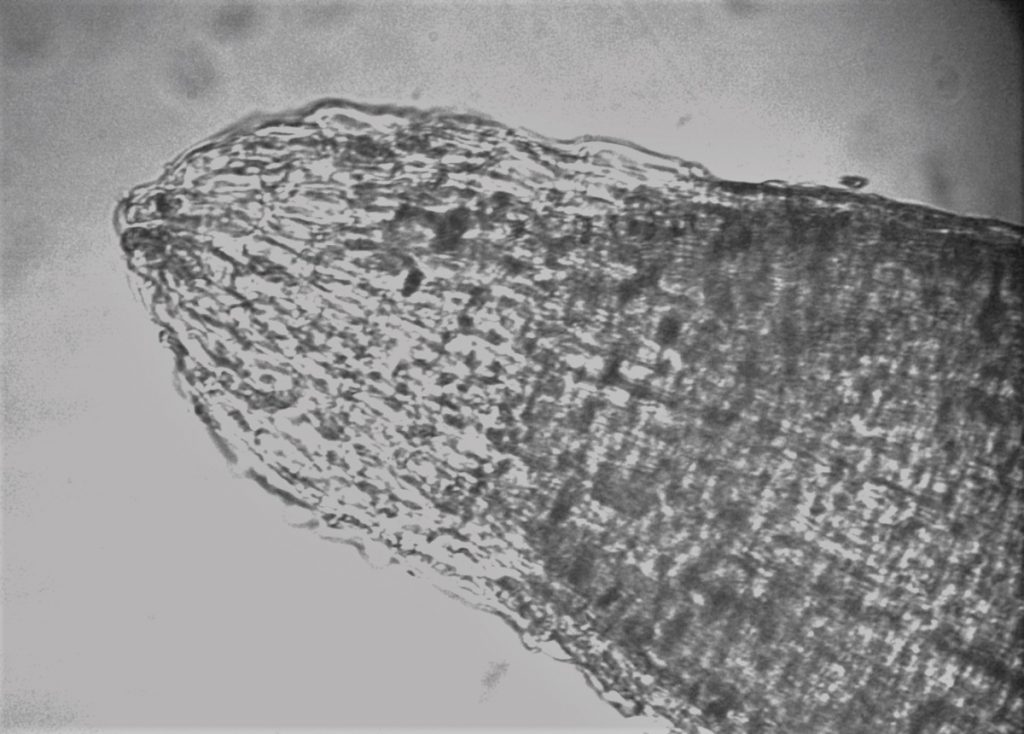How to remove harmful E.coli
Professor Ann Matthysse is a geneticist based at the University of North Carolina at Chapel Hill, USA. She is investigating E.coli to understand how these bacteria bind to plant surfaces. The findings could help us learn how to remove them and make foods, like lettuce, safer
On 20 November 2018, the Center for Disease Control and Prevention (CDC) and US Food & Drug Administration (FDA) announced that they were investigating an outbreak of Escherichia coli (E. coli) infections believed to be linked to romaine lettuce. Fortunately, by 9 January 2019, the outbreak had ended, although 62 people in 16 states were infected.
While the majority of E. coli are harmless (and are found in a healthy body), some cause diarrhoea, bloodstream infections, encephalitis and other illnesses. The CDC estimates that there are around 265,000 food-borne E. coli infections in the US every year – so understanding more about the mechanisms behind E. coli infections and finding a means of reducing their occurrence is very important.
TALK LIKE A GENETICIST
ESCHERICHIA COLI
Also known as E. coli, it is a type of bacteria that normally lives in the intestines. The majority of types of E. coli are harmless, but some strains can cause diarrhoea.
BACTERIAL BINDING
An essential step in bacterial infection, which enables bacteria to stick to other cells or surfaces.
ABIOTIC FACTORS
Non-living variables that can influence where organisms live, such as temperature and light intensity.
AGROBACTERIUM
A bacterium capable of transferring a segment of its genome to plant cells. It is used to make genetically altered plants.
POLYSACCHARIDES
Long chains of carbohydrate molecules that help store energy (starch is an example) or provide structural support (cellulose is an example).
SALMONELLA
A common bacterium that makes people ill. It infects many more people than E. coli and, unlike E. coli, can break down plant tissue to enter the interior of the plant.
WHAT IS BEING DONE TO UNDERSTAND MORE ABOUT E. COLI?
Professor Ann Matthysse is based at the University of North Carolina at Chapel Hill in the US. Her team is investigating E. coli to identify the genes and gene products that allow these bacteria to bind to plant surfaces such as lettuce, alfalfa sprouts, peppers and radishes. Gene products might be proteins that are directly involved in binding, or they might be enzymes that are involved in synthesising polysaccharides such as cellulose, which are involved in binding.
It is known that the bacteria that bind to the surface of plants are not removed by washing with water, although they can still be killed by heat. The issue is that lettuce and other salad vegetables tend to be served cold after rinsing them under the tap, so if there are any harmful bacteria on their surface, they will remain there. “If we can discover how the bacteria bind to a plant surface it is possible that we can find a way to remove them,” explains Ann. “We could even find a way of preventing their binding during harvesting and cut the problem off at the source.”
 PROFESSOR ANN MATTHYSSE
PROFESSOR ANN MATTHYSSE
Department of Biology, University of North Carolina at Chapel Hill, USA
FIELD OF RESEARCH: Bacterial Genetics
RESEARCH PROJECT: Ann’s research is focused on developing understanding on the mechanisms behind E. coli binding to the surface of plants. The findings could help prevent incidences of E. coli outbreaks and stop people becoming ill.
HOW MANY KNOWN STRAINS OF E. COLI ARE THERE?
Nobody is entirely sure how many strains there are. The number is likely to be in the thousands at least, although the majority will cause no harm. Research shows that there are around 200 different toxin-producing strains, of which more than 100 have been associated with human illness. (Salmonella, which are closely related to E. coli and also cause food-borne illness, generally do not contain genes for the toxins made by E. coli.) “All of these E coli strains exchange genes with each other, have a core genome of about 2,000 genes, and a variable set of other genes called the pangenome,” says Ann. “Each strain has between 2,000 and 4,000 genes from the pangenome, which contains more than 10,000 genes.”
Reference
https://doi.org/10.33424/FUTURUM62
While the majority of E. coli are harmless (and are found in a healthy body), some cause diarrhoea, bloodstream infections, encephalitis and other illnesses. The CDC estimates that there are around 265,000 food-borne E. coli infections in the US every year – so understanding more about the mechanisms behind E. coli infections and finding a means of reducing their occurrence is very important.
TALK LIKE A GENETICIST
ESCHERICHIA COLI
Also known as E. coli, it is a type of bacteria that normally lives in the intestines. The majority of types of E. coli are harmless, but some strains can cause diarrhoea.
BACTERIAL BINDING
An essential step in bacterial infection, which enables bacteria to stick to other cells or surfaces.
ABIOTIC FACTORS
Non-living variables that can influence where organisms live, such as temperature and light intensity.
AGROBACTERIUM
A bacterium capable of transferring a segment of its genome to plant cells. It is used to make genetically altered plants.
POLYSACCHARIDES
Long chains of carbohydrate molecules that help store energy (starch is an example) or provide structural support (cellulose is an example).
SALMONELLA
A common bacterium that makes people ill. It infects many more people than E. coli and, unlike E. coli, can break down plant tissue to enter the interior of the plant.
WHAT IS BEING DONE TO UNDERSTAND MORE ABOUT E. COLI?
Professor Ann Matthysse is based at the University of North Carolina at Chapel Hill in the US. Her team is investigating E. coli to identify the genes and gene products that allow these bacteria to bind to plant surfaces such as lettuce, alfalfa sprouts, peppers and radishes. Gene products might be proteins that are directly involved in binding, or they might be enzymes that are involved in synthesising polysaccharides such as cellulose, which are involved in binding.
It is known that the bacteria that bind to the surface of plants are not removed by washing with water, although they can still be killed by heat. The issue is that lettuce and other salad vegetables tend to be served cold after rinsing them under the tap, so if there are any harmful bacteria on their surface, they will remain there. “If we can discover how the bacteria bind to a plant surface it is possible that we can find a way to remove them,” explains Ann. “We could even find a way of preventing their binding during harvesting and cut the problem off at the source.”
 PROFESSOR ANN MATTHYSSE
PROFESSOR ANN MATTHYSSE
Department of Biology, University of North Carolina at Chapel Hill, USA
FIELD OF RESEARCH: Bacterial Genetics
RESEARCH PROJECT: Ann’s research is focused on developing understanding on the mechanisms behind E. coli binding to the surface of plants. The findings could help prevent incidences of E. coli outbreaks and stop people becoming ill.
HOW MANY KNOWN STRAINS OF E. COLI ARE THERE?
Nobody is entirely sure how many strains there are. The number is likely to be in the thousands at least, although the majority will cause no harm. Research shows that there are around 200 different toxin-producing strains, of which more than 100 have been associated with human illness. (Salmonella, which are closely related to E. coli and also cause food-borne illness, generally do not contain genes for the toxins made by E. coli.) “All of these E coli strains exchange genes with each other, have a core genome of about 2,000 genes, and a variable set of other genes called the pangenome,” says Ann. “Each strain has between 2,000 and 4,000 genes from the pangenome, which contains more than 10,000 genes.”
DO E. COLI BACTERIA PREFER CERTAIN PLANTS?
It is not really the type of plant that E. coli bacteria prefer – it is more the part of the plant. Most of the surface of plants is covered with a waxy cuticle that helps prevent water loss. The bacteria don’t bind well to waxy surfaces, so they prefer to bind to the part of the root where water uptake occurs. The bacteria can also get into the plant through the stomata in the leaves where the plant absorbs CO2. However, to get into the stomata, the bacteria must be motile (i.e. capable of motion) and have some water to swim in.
WHAT HAS ANN’S TEAM DISCOVERED SO FAR?
Ann and her team have found that E. coli bacteria are quite sneaky in their approach. They use several different mechanisms to bind to plant surfaces, so if one method is prevented, the bacteria use a different method. However, there are some positives that can be taken from the research. “Many of the methods of binding may be controlled and turned on by a common set of regulatory genes,” says Ann. “If we could inhibit the expression of these genes, we might be able to prevent or at least markedly decrease bacterial binding.”
They have also found that E. coli doesn’t break plant tissue down to enter the interior of the plant (which is in contrast to Salmonella). Ultimately, this means that surface sterilisation techniques might help reduce the number of E. coli, suggesting a possible avenue for exploring ways to limit infections.
ABOUT GENETICS
Genetics is a field of biology that is focused on genes and genetic variation. A gene is a short section of DNA – they are so small that you have approximately 20,000 of them inside every cell in your body and you inherit them from your parents. Genes contain the information that causes cells to make molecules called proteins. These proteins are responsible for performing functions to keep the cells and the organism healthy. Genes determine things as diverse as the colour of your eyes or what height you will grow to. They may also influence your susceptibility to various diseases such as cancer.
WHAT ARE GENE VARIANTS?
Gene sequences can vary from person to person. Fortunately, most of these variants are harmless, but sometimes they affect proteins that are responsible for important things and you can become ill. This is one of the reasons geneticists are so important – they investigate these variants to understand which ones increase your chances of developing particular illnesses. This information can help us to develop better treatments.
WHY DO SCIENTISTS STUDY GENES?
The more we learn about genes, the more we can use this knowledge to help prevent and treat illness. In Ann’s case, she is studying the genes and gene variants in E. coli to understand how they bind to plant surfaces. By understanding exactly how E. coli do this, Ann and her team could stop this happening and make illness caused by eating toxigenic E. coli a thing of the past. Because there are so many genes controlling so many processes in living things, there is a lot that geneticists like Ann would like to learn.
WOULD ANN RECOMMEND A CAREER IN GENETICS?
Yes! “Genetics is a quickly expanding field, especially as gene sequencing has become easier and cheaper,” says Ann. “There are plenty of jobs out there, ranging from genetic counselling through to basic research.” Irrespective of which particular job you would like to do within the field of genetics, there are many opportunities in the US in medicine, industry and academia.
HOW TO BECOME A GENETICIST
• The Science Careers arm of the American Association for the Advancement of Science (AAAS) should give you some idea of how broad the subject is and the myriad roles it could lead to.
• The Genetics Society of America is an international community that is dedicated to advancing the field of genetics. We encourage you to explore at your own leisure, but you should certainly sign up for the email newsletter to keep up to date with important news and career opportunities.
• Genes & Health explains more about genes, genetic variants and DNA. The site includes a link to a video that shows how proteins are made in the cell from the information in the DNA code.
• www.environmentalscience.org is a tremendous resource and has an entire section dedicated to geneticists. According to them, you can expect to earn an average
At school and college, you should consider studying:
• chemistry
• biology
• statistics
• computer science
• molecular biology
• genetics
• evolution
MEET THREE OF ANN’S UNDERGRADUATE BIOLOGY STUDENTS

JANINE CORLEY
To help Ann with her research, I washed store-bought lettuce, alfalfa sprouts and parsley with either water or water and detergent. I then viewed the bacteria bound to the plant’s surface under the light microscope and compared it against the unwashed plants. In doing this, I was able to explore how washing vegetables can affect the number of bacteria that bind to plant surfaces.
I have always wanted a career in a science-related field. My dream jobs as a child were scientist, entomologist, doctor or veterinarian.
Growing up, I loved biology and chemistry. When I was in primary school, I enjoyed learning about the world around me and the diverse ecosystems, animals and abiotic factors. Moving into secondary school and college, I developed this passion further through performing experiments. I love how science is guided by curiosity and that the associated research helps solve real-world problems.
My love for biology started at a very young age. I used to go outside and explore my backyard, looking for animals and bugs with a magnifying glass from a home science kit. I found loads of cool things because I lived on a large property surrounded by woods. Even though I do not think I had a single inspiration for biology, I would say my family encouraged me to continue my interest in this field and has supported me, thus cultivating my love for science.
Ann has helped me grow as a researcher throughout college and prepared me for my career. She has taught me how to work in a lab and encouraged me to independently ask questions and perform experiments. By working with her, I have also learned a great deal about microbiology and, specifically in this research, bacterial binding. When I have completed my undergraduate degree, I hope to attend medical school.

KATIE HOLT
When I was younger, I wanted to be an engineer like my dad! I enjoyed science classes most in
school. I think I enjoyed them so much because I was intrigued about our natural world. I am very interested in the unknown and am naturally a curious person, so when I looked outside at trees and animals, I wanted to know how they worked and what they were made of. Science classes gave me those answers.
I was interested in studying biology because the more I learned about the subject, the more I realised I didn’t know. The benefit of working with Ann is that I can gain a lot of laboratory skills. Ann’s lab is composed of only undergraduate students, so we have to learn to do everything without the help of graduate students – something many other labs cannot teach. These skills are very important for future research and for life in general because you learn to work independently!
Like Janine, I would also like to go to medical school in the future.

LAUREN BURKE
I’ve always known I wanted to go into the medical field but didn’t really know exactly what I wanted to do until 8th grade. I decided to become a Physician Assistant (PA) and have been working towards that ever since then.
Ann has a passion for microbiology that is really inspiring and makes me strive to learn more. She gives her students the independence to think about their own research projects – I feel as though I understand the mechanisms of bacterial pathogens much more clearly because of these research opportunities. It has greatly helped me master material in my biology classes and creates an environment where I can physically see results from our experiments. Understanding how microorganisms function, and how genetics and mutations are involved in their everyday functions, has made processes within the human body much clearer.
I’ve always wanted to be part of the healthcare system and know more about the processes of the body. I loved helping in a hospital setting and observing medical cases, even in high school.
I plan to attend PA School after taking a gap year to work in emergency medicine.
ANN’S TOP TIPS
01 You should always remember that you will be spending around 40 hours per week doing whatever you choose for a career. It is important to pick something you find really interesting and enjoyable.
02 Sometimes it is better to see how things work out, rather than have a definite plan for your life and career. I was drawn to biology and genetics by chance – when I was at university, I found that if you majored in biochemistry you got a faculty tutor. This wasn’t available in any other sciences. My tutor, Professor A M Pappenheimer, was a microbiologist and that got me interested in the field.
03 The Biology Department at The University of North Carolina at Chapel Hill offers a number of outreach activities to high school students, such as internships, talks and school visits. I encourage you to check whether any universities in your area are






